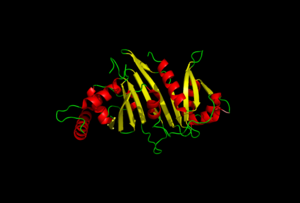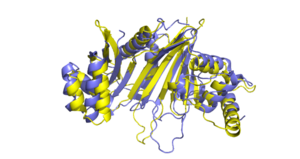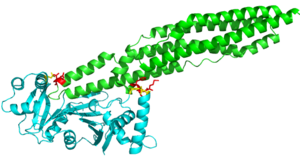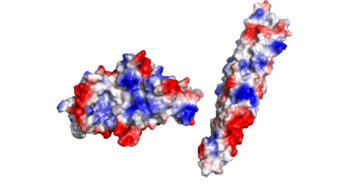Sandbox Reserved 1075
From Proteopedia
(Difference between revisions)
| Line 2: | Line 2: | ||
<StructureSection load='4KXR' size='340' side='right' caption='Here shows PE25-PPE41 ligand bound to EspG5 protein. Resolution 2.60Å' scene=''> | <StructureSection load='4KXR' size='340' side='right' caption='Here shows PE25-PPE41 ligand bound to EspG5 protein. Resolution 2.60Å' scene=''> | ||
| - | EspG is a key secretion protein involved with the virulence of ''mycobacterium tuberculosis''. The specificity of EspG binding affinity to its specific PE-PPE ligand has many contributing factors. The four different EspG proteins found in ''mycobacterium tuberculosis'' have different characteristics that influence binding, where EspG5 binds to the most PE-PPE proteins. Here EspG PE-PPE complex is to be excreted in the ESAT-6 pathway. | + | EspG is a key secretion protein involved with the virulence of ''mycobacterium tuberculosis''. The specificity of EspG binding affinity to its specific PE-PPE ligand has many contributing factors. The four different EspG proteins found in ''mycobacterium tuberculosis'' have different characteristics that influence binding, where EspG5 binds to the most PE-PPE proteins. Not all EspG proteins bind to the same ligand, specific interactions from specific residue interactions, electrostatics, steric hinderance and concavity of the EspG binding pocket influence binding. Here the EspG PE-PPE complex is to be excreted in the ESAT-6 pathway, this pathway is an attractive target for inducing apoptosis in Mtb. |
Revision as of 12:53, 7 April 2015
Binding Specificity of EspG Proteins to PE-PPE Proteins in mycobacterium tuberculosis
| |||||||||||
References
- ↑ Ekiert DC, Cox JS. Structure of a PE-PPE-EspG complex from Mycobacterium tuberculosis reveals molecular specificity of ESX protein secretion. Proc Natl Acad Sci U S A. 2014 Oct 14;111(41):14758-63. doi:, 10.1073/pnas.1409345111. Epub 2014 Oct 1. PMID:25275011 doi:http://dx.doi.org/10.1073/pnas.1409345111




